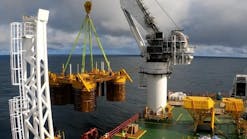ExxonMobil starts Liza Phase-2 production at Stabroek block
ExxonMobil Corp. started production at Liza Phase 2, Guyana’s second offshore oil development on Stabroek block, bringing total production capacity to more than 340,000 b/d in 7 years since the country’s first discovery.
The Liza Unity floating, production, storage, and offloading (FPSO) vessel arrived in Guyana in October 2021 and is moored in about 1,650 m of water. It will be able to store around 2 million bbl of crude. Production at the Liza Unity is expected to reach its target of 220,000 bbl later this year.
The FPSO adds to the more than 120,000 b/d of capacity at the Liza Destiny FPSO, which began production in December 2019 and is delivering at better than design capacity.
Liza Unity is the world’s first FPSO to be awarded the SUSTAIN-1 notation by the American Bureau of Shipping in recognition of the sustainability of its design, documentation, and operational procedures, the operator said.
Stabroek projects
Stabroek block’s recoverable resource base is estimated at more than 10 billion boe and has the potential to support up to 10 projects. ExxonMobil anticipates that four FPSOs with a capacity of more than 800,000 b/d will be in operation on the blocl by yearend 2025.
Payara, the third project in the block, is expected to produce about 220,000 b/d using the Prosperity FPSO vessel, which is currently under construction. The field development plan and application for environmental authorization for the Yellowtail project, the fourth project in the block, have been submitted for government and regulatory approval.
ExxonMobil affiliate Esso Exploration and Production Guyana Ltd. is operator at Stabroek block (45%) with partners Hess Guyana Exploration Ltd. (30%) and CNOOC Petroleum Guyana Ltd. (25%).

Alex Procyk | Upstream Editor
Alex Procyk is Upstream Editor at Oil & Gas Journal. He has also served as a principal technical professional at Halliburton and as a completion engineer at ConocoPhillips. He holds a BS in chemistry (1987) from Kent State University and a PhD in chemistry (1992) from Carnegie Mellon University. He is a member of the Society of Petroleum Engineers (SPE).
